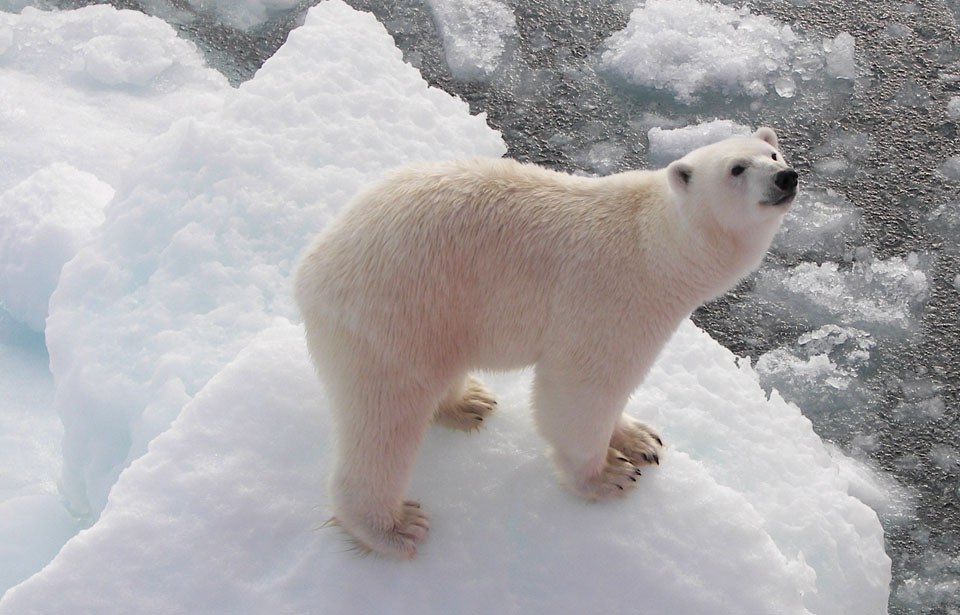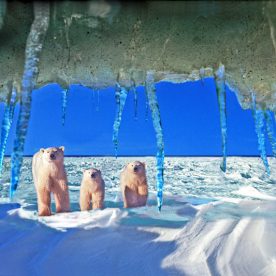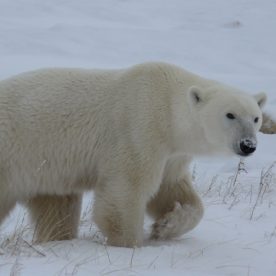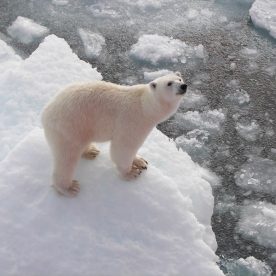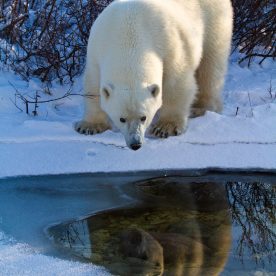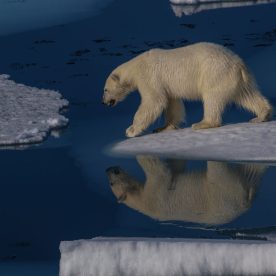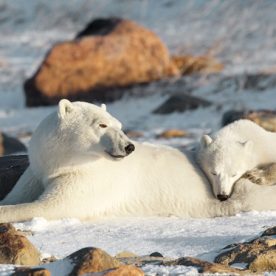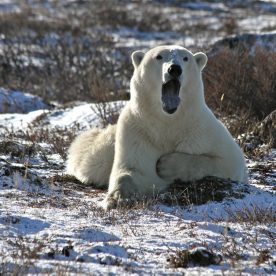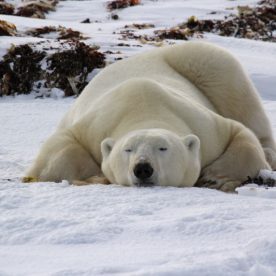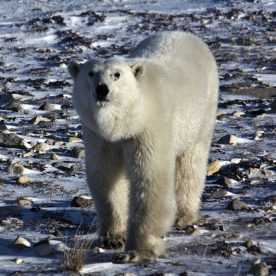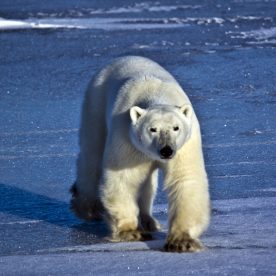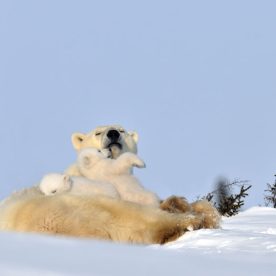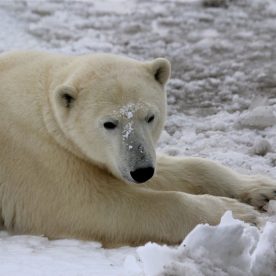Description
With its distinctive massive body and long neck, the polar bear Ursus maritimus is the largest land carnivore, or meat eater. The white coats of the adults often appear cream to yellow against the dazzling whiteness of their home, the arctic pack ice. Adult males measure from 240 to 260 cm in total length and usually weigh from 400 to 600 kg, although they can weigh up to 800 kg—about as much as a small car. They do not reach their maximum size until they are eight to 10 years old. Adult females are about half the size of males and reach adult size by their fifth or sixth year, when most weigh from 150 to 250 kg. Pregnant females can weigh up to 400 or 500 kg just before entering their maternity dens in the fall.
The bodies of polar bears are longer than the bodies of brown bears; their necks and skulls are also longer, but their ears are smaller. Instead of having the characteristic “dished” or concave facial profile of brown bears, polar bears possess a more prominent or “Roman” nose. Their canine teeth are large, and the grinding surfaces of their cheek teeth are jagged, which is an adaptation to a carnivorous diet. Polar bear claws are brownish in colour, short, fairly straight, sharply pointed, and non-retractable.
Signs and sounds
Polar bears use a deep growl to warn off other bears, particularly when defending a food source. They also hiss and snort to show aggression, accompanied by a lowered head and ears laid back. Angry polar bears communicate their displeasure with loud roars and growls. They also emit a “chuffing” sound in response to stress. Mother bears scold their cubs with a low growl or a soft cuff.
Habitat and Habits
Polar bears prefer areas of annual ice, which they use for a hunting platform and protective cover, interspersed with snow-drifted pressure ridges, refrozen cracks, and polynyas, or areas of open water surrounded by ice. This habitat preference is closely linked to the presence of their favourite food, ringed seals.
In areas such as eastern Baffin Island and Hudson Bay, where most or all of the pack ice melts by mid- to late summer, the whole bear population is forced to come ashore for two to four months in summer and early fall to wait for the ice to freeze again.
Polar bears are wonderfully adapted to their arctic surroundings. Their thick winter coats, with glossy guard hairs and dense underfur, and the thick layer of fat beneath their skin protect them against the cold. The guard hairs also shed water easily, so that after a swim the polar bear can shake itself like a dog to decrease chilling and speed the drying process. Polar bear hair is translucent and reflects the heat from the sun down to the base of the hair, where it is absorbed by the black skin.
The white colour of the polar bear also serves as camouflage. Polar bears are clever in their use of cover, be it land, water, or ice. This aids both their hunting of seals and their own escape from human hunters. The bears’ feet have small bumps and cavities on the soles that act like suction cups, helping to keep the bears from slipping on the ice.
Probably the most significant adaptation of polar bears to the uncertainties of food availability in the Arctic is their ability to slow down their metabolism to conserve energy at any time of year. This occurs after seven to 10 days of not being able to feed and lasts until food becomes available again. In comparison, black or brown bears can slow down their metabolism only in response to not feeding in the late fall, just before they enter their dens for the winter. If food is removed from black or brown bears in spring or summer when they are not in their winter dens, they will simply starve to death.
Although polar bears of both sexes and all ages may occupy temporary dens or shelters during periods of cold or stormy weather, only pregnant females remain in dens throughout the winter.
The bears’ normal gait is a slow, lumbering walk of about 5 to 6 km per hour. They may gallop when chased, but they usually do not like to run for long. Immature bears can run as far as 2 km, but older bears tire quickly because they are fat and well insulated, which causes them to overheat fairly quickly.
Polar bears will usually not attack humans except to protect their cubs or because they are starving.
Male polar bears commonly live to about 25 years of age. Females often live into their late twenties.
Unique characteristics
When hunting, polar bears rely mainly on their keen sense of smell. They can detect seal breathing holes covered by layers of ice and snow 90 cm or more thick and up to a kilometre away. Their eyesight and hearing are probably similar to those of a human.
Polar bears are excellent swimmers. They use their large front paws as powerful oars when they swim, while their rear paws trail behind and act like rudders. Underwater, they keep their eyes open. A polar bear may remain submerged for over a minute.
Range
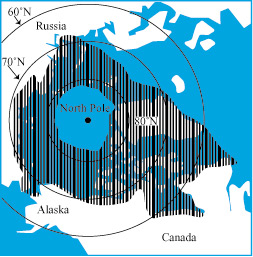 Polar bears are most common along the coastal areas of the Arctic and the between-island channels of the various archipelagos, or groups of islands, in the Arctic. Small numbers of bears enter the permanent pack ice that lies over the central polar basin, and some have been recorded as far north as 88°N latitude. (The North Pole, which gives the “polar” bears their name, is at 90°N latitude.) A few polar bears regularly appear as far south as Newfoundland and Labrador, and they have occasionally been noted in the Gulf of St. Lawrence in years when heavy pack ice drifts further to the south than normal.
Polar bears are most common along the coastal areas of the Arctic and the between-island channels of the various archipelagos, or groups of islands, in the Arctic. Small numbers of bears enter the permanent pack ice that lies over the central polar basin, and some have been recorded as far north as 88°N latitude. (The North Pole, which gives the “polar” bears their name, is at 90°N latitude.) A few polar bears regularly appear as far south as Newfoundland and Labrador, and they have occasionally been noted in the Gulf of St. Lawrence in years when heavy pack ice drifts further to the south than normal.
One of the three largest maternity denning areas for polar bears worldwide is in Canada, near Churchill, Manitoba, on the western coast of Hudson Bay. The others are on Wrangel Island, in Russia, and in Kong Karls Land in Svalbard, Norway, in the Arctic Ocean.
Feeding
Polar bears are considered to be marine mammals because they depend upon seals and the marine environment for their existence. They feed mostly on ringed seals, but they also catch bearded seals, harp seals, hooded seals, and harbour seals. Occasionally, they may also kill walruses, belugas or white whales, and narwhals.
During the winter and spring, adult ringed seals maintain breathing holes in the fast ice by constantly scratching the ice with the heavy claws on their foreflippers. Younger seals are more abundant in areas where there is some open water during winter, such as adjacent to shore leads and polynyas, or stretches of areas of open water surrounded by ice, because it is easier to breathe there and they are able to avoid dominant adult seals that are more abundant in the fast ice.
The polar bears’ large front paws are useful for hunting seals. When the seal comes up to the breathing hole for air, the polar bear kills it and flips it out of the water with a single blow of its paw.
During April and May, polar bears, especially females accompanied by dependent cubs, hunt for newborn ringed seals, or whitecoats, in their birth lairs in the underside of the snowdrifts that cover the seals’ breathing holes. After smashing into the lairs and killing the seals, the bears eat mainly the fat and skin, often leaving much of the meat for scavengers. Seal pups and their mothers constitute the main part of the spring diet of polar bears, except for the nursing cubs.
Bears also stalk basking seals on land-fast ice or ice pans. During spring and early summer, when seals are most accessible, a bear may catch one every four to five days. The bear eats the fat as quickly as possible before another bear smells the kill and comes to compete for some of the carcass.
When the bears come ashore in areas where the pack ice melts during the summer, they can no longer hunt seals. They live mainly on their fat stores and conserve energy by remaining inactive over 80 percent of the time. They will scavenge on carcasses if they find them, and adolescents and females accompanied by dependent young, in particular, will occasionally eat grasses and berries. Bears have even been seen diving for seaweed and trying to catch seabirds sitting on the water by swimming underwater and coming up beneath them. Very few cases of bears killing and eating caribou and muskoxen are known.
Breeding
Males and females become sexually mature when they are four or five years old. Although the females may mate then and produce cubs, it is unlikely that many males breed until they are eight to 10 years old. Because cubs usually stay with their mothers for two and a half years, the most often a female is normally capable of having a litter is every three years. This is a very slow breeding rate, which explains why depleted populations take so long to recover.
Mating occurs in April and May, when polar bears are out on the pack ice hunting seals. However, the fertilized egg does not implant in the uterus and begin to grow until mid-September to mid-October. Through most of the Arctic, maternity denning begins about mid-October. The pregnant females search for deep snowdrifts near the coast. Often they excavate their dens on the south-facing slopes of hills or valleys, where prevailing northerly winds pile up deep snowdrifts.
Dens vary in size, but the maternity denning chamber, at the upper end of an entrance tunnel 1 to 2 m long, averages a diameter of 1.5 m and a height of 90 to 100 cm in the middle. The opening to the entrance tunnel is sealed with drifted snow shortly after the female excavates her den. The chamber is higher than the entrance tunnel, trapping any warmer air from the bears there. As a result, when the den is occupied, the inside temperature remains only a few degrees below 0°C throughout the winter, regardless of how cold the outside air temperature becomes.
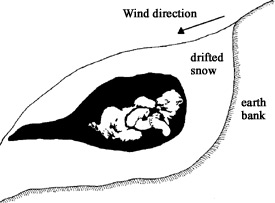 The young are born after about two months of gestation, or pregnancy, from late November to early January, depending on latitude. The most common litter size is twins, followed by singletons. Triplets are born periodically, especially when feeding conditions have been good and the females are able to put on a lot of fat before denning; quadruplets have also been recorded, although this is extremely rare.
The young are born after about two months of gestation, or pregnancy, from late November to early January, depending on latitude. The most common litter size is twins, followed by singletons. Triplets are born periodically, especially when feeding conditions have been good and the females are able to put on a lot of fat before denning; quadruplets have also been recorded, although this is extremely rare.
At birth, the cubs are only about 25 cm long and weigh less than one kilogram. Their eyes are closed at birth, and they are covered with hair so fine that in some early descriptions the cubs were reported to be hairless.
Most family groups in lower Hudson Bay break out of their dens from late February to mid-March, and up to one month later in the High Arctic. The family remains at the den site for one to two weeks, getting used to the cold and exercising. If the subsequent journey to the sea ice is more than a few kilometres, the females may stop two or three times a day to rest, feed the cubs, and warm them. Once back on the sea ice and hunting continuously, the female periodically digs resting pits in the snow, sheltered from the prevailing wind, where she nurses the cubs and where they can all sleep.
The family group breaks up when the cubs are about two and a half years old. Occasionally, cubs remain with their mothers until they are three and a half years old, and in western Hudson Bay, some mothers wean, or stop nursing, their cubs only when the cubs are one and a half years old. The most difficult time in a polar bear’s life is probably its first year of independence. It is still learning to hunt proficiently, and, when it does catch a seal, it is likely to have the carcass taken away by larger bears.
Conservation
Untanned polar bear pelts sell for $500 to $3 000, depending on their size and quality. This can make up a significant portion of an Inuk hunter’s cash income. Within the annual quota assigned to each coastal village in the Northwest Territories and Nunavut, hunters are also allowed to allocate a number of hunting tags to non-resident sport hunters, who are guided on a polar bear hunt by local Inuit hunters for fees that are normally in the range of $18 000 to $20 000 per hunt. This is an important source of cash income for small settlements in northern Canada. The annual economic value of the guided sport hunt and the hides is about $1 million in Canada.
The tags from unsuccessful guided sport hunts cannot be reallocated to different hunters, and one consequence of that practice is that fewer bears are killed in total than would be the case if all the tags were allocated to subsistence hunters, or people who hunt in order to provide food for their families. Also, because most sport hunters seek large males, fewer adult females are killed overall, which provides some additional protection for the reproductive component of the population.
Polar bears are also highly valued as display animals in zoos and are one of the central attractions of the famous Moscow circus.
Bear meat may be eaten by humans and is often used as dog food. However, polar bear meat is sometimes infected with trichinosis, so it should be cooked thoroughly before being eaten. Polar bear liver can also be dangerous to humans and dogs because of its high vitamin A concentrations.
Although polar bears are not in immediate danger of extinction, they face threats common to all large predators: human encroachment on their habitat, illegal hunting, and chemical contaminants in their prey. A new threat appears to be global warming or climate change, which is affecting the polar bear’s habitat by reducing the total ice cover in the Arctic, thinning the permanent pack ice of the central polar basin, and changing the timing of freeze-up and breakup in more southerly areas, such as Hudson Bay. The Committee on the Status of Endangered Wildlife in Canada has designated the polar bear as a species of special concern in Canada because of characteristics that make it particularly sensitive to human activities or natural events.
The current world polar bear population is probably 25 000 to 30 000. The Canadian population likely exceeds 15 000. The human hunter is the primary predator of the polar bear. In recent years, hunters throughout the world have killed fewer than 1 000 yearly. Between 500 and 600 of these are taken by Inuit and Amerindian hunters in Canada under a system of annual quotas that is reviewed annually in Nunavut, the Northwest Territories, Yukon, Ontario, Manitoba, Quebec, and Newfoundland and Labrador.
The Canadian Wildlife Service has been studying the ecology of polar bears since 1961. This research provides information on population size, growth rates, reproduction rates, movements, levels of toxic chemical contamination, and the effects of long-term climatic and ecological change. The Canadian Wildlife Service is also represented on two permanent national polar bear committees (one comprising scientists and the other senior administrators), each of which meets annually to review new research results and management problems within Canada.
Conservation of polar bears requires international cooperation, as several populations are shared between countries and as problems such as contaminants and climatic change are affecting the whole Arctic. Since 1965, an international group of scientists specializing in studying polar bears has been coordinating research and management of polar bears throughout the Arctic under the auspices of the International Union for Conservation of Nature and Natural Resources (IUCN), also known as the World Conservation Union. Five countries—Canada, Denmark, Norway, the United States, and the U.S.S.R.— igned an International Agreement on the Conservation of Polar Bears in Oslo, Norway, in 1973. The agreement came into effect in 1976. The Canadian Wildlife Service is represented on the IUCN/Species Survival Commission Polar Bear Specialists Group, which meets every three or four years and provides advice on international aspects of research and conservation to the IUCN and to the nations that signed the Polar Bear Agreement.
At present, the polar bear is one of the best managed of the large arctic mammals. If all the arctic nations continue to abide by the terms and intent of the Polar Bear Agreement, the future of this magnificent species should be secure.
Resources
Online resources
Conservation of Polar Bears in Canada
Print resources
Larsen, T. 1978. The world of the polar bear. Hamlyn, London.
Stirling, I. 1988. Polar bears. University of Michigan Press, Ann Arbor, Michigan; and Fitzhenry and Whiteside, Markham, Ontario.
© Her Majesty the Queen in Right of Canada, represented by the Minister of the Environment, 2002. All rights reserved.
Catalogue number CW69-4/18-2003E-HTML
ISBN 0-662-34995-4
Text: I. Stirling
Photo: Bev McMullen
Sketch: Wendy Kramer



